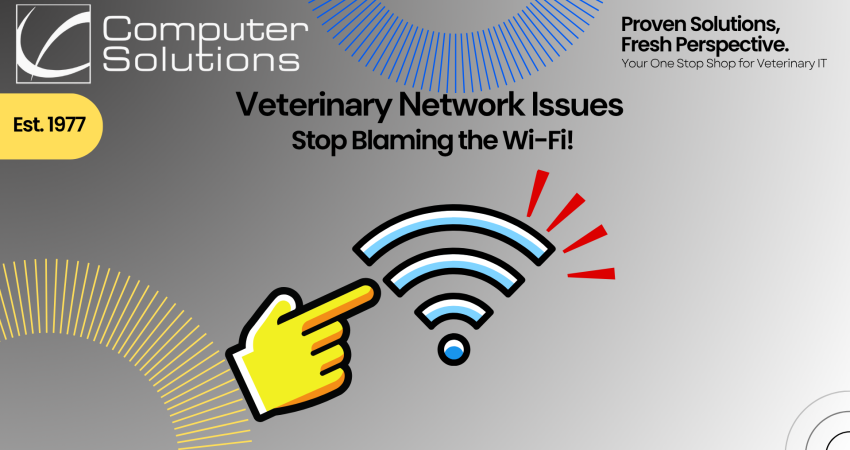
Posted by Computer Solutions on October 6, 2025
When the schedule is packed, a client is waiting at checkout, and the payment terminal suddenly freezes, or your imaging software lags during a critical exam, it’s easy to blame the Wi-Fi.
But the truth is, veterinary network issues aren’t always caused by a weak wireless signal. In fact, the bars you see on a screen can be misleading. A full signal doesn’t mean fast speed—and a weak signal isn’t always the root cause.
What feels like “bad Wi-Fi” might actually be something else entirely.
Network performance problems in clinics often come down to outdated infrastructure, device overload, bandwidth mismatches, or overlooked bottlenecks. Let’s walk through the most common culprits and how you can start diagnosing the issue—no advanced IT knowledge required.
1. Outdated Networking Equipment
Your router is the traffic cop of your clinic’s digital life. And if it’s still the one that came with your internet package or hasn’t been updated since the Obama administration, it’s likely struggling to keep up.
Most veterinary clinics today are running cloud-based PIMS systems, lab integrations, payment platforms, and remote access tools, all at the same time. Consumer-grade routers, especially older models, weren’t built to juggle that kind of traffic.
Even if your internet plan boasts “fast speeds,” the router and switch sitting in your network closet may be the reason your devices crawl during peak hours.
Pro tip: Business-grade routers can prioritize traffic for essential tools like your practice management system and payment processors. If your equipment can’t do that, it’s time for an upgrade.
2. Too Many Devices Competing for Bandwidth
Think about all the devices connected to your network right now. Not just workstations and printers, but:
- Exam room tablets
- Phones
- Smart thermostats or cameras
- Break room smart TVs
- Mobile devices from staff and clients
Now multiply that by the number of people in your building on any given day.
All of these devices use bandwidth, even when they’re idle or just syncing updates. It’s one of the most common causes of veterinary network issues, and it can sneak up on you. Especially when retired devices are still plugged in and forgotten.
Tip: Unused devices should be disconnected and removed from your Wi-Fi entirely. Even better? Have your IT provider review and clean up your active connections each quarter.
3. Underpowered Internet Plan
Veterinary clinics use a lot more internet than they used to, even if your workflows haven’t changed dramatically. The shift to cloud storage, real-time backups, video consults, and online client communication means your data usage has probably outpaced your current internet plan.
If your internet package was chosen five years ago to handle web browsing and email, it may now be slowing everything down, even if it’s still technically working.
Upload speed matters, too. Imaging, cloud backups, and video calls depend on sending data out quickly, not just downloading it. Unfortunately, many clinics only look at download speed when evaluating their plan.
Consider: Are your backups running after hours and slowing down morning performance? Are uploads taking longer than they should? A bandwidth audit can reveal whether your plan is part of the problem.
4. Unmanaged Guest or Staff Access
Let’s say your imaging software lags every day around lunch. Is it the software? Or is your network being used to stream Netflix and update smartphones?
Guest Wi-Fi access is a nice touch for clients, and most teams need a little lunchtime recharge. But if your clinic’s network doesn’t segment business-critical devices from casual ones, everyone’s traffic is fighting for space.
Without proper traffic management or bandwidth allocation, you’re rolling the dice every time someone connects a new device.
Fix: Separate your clinic’s network into at least two channels: one for clinic operations, and one for guests or personal devices. Ensure critical systems always get priority.
5. Aging Workstations Masquerading as Network Problems
Not every slow system is a network issue. Sometimes the PC itself is the problem.
Outdated workstations can’t keep up with modern applications, especially if they’re running on spinning hard drives, have limited RAM, or are stuck on unsupported operating systems. These machines often freeze, crash, or lag. Even if the network is working perfectly!
The result? The team thinks the Wi-Fi is broken, but it’s really a hardware issue.
Test it: If one computer is slow but others are fine, the issue is probably the machine and not the internet.
How to Diagnose the Real Problem
You don’t need to be a network engineer to spot patterns:
- If all devices slow down at the same time: suspect bandwidth or the router.
- If only one device lags: it might be the PC itself.
- If the problem shows up only during certain hours, look at guest usage or background processes like backups.
At Computer Solutions, we use real-time network monitoring and remote management tools to pinpoint the exact cause of the slowdown without the guesswork. That means fewer disruptions, faster resolutions, and less stress on your team.
Let’s Fix Your Network, Not Just Your Wi-Fi
If your clinic is struggling with unreliable systems, unexplained lags, or slow internet that seems to strike at the worst moments, it’s time to take a deeper look.
We help veterinary practices across the US identify and eliminate hidden veterinary network issues. From router replacements and bandwidth upgrades to smarter device management and hardware refreshes, we do it all.
Schedule your free network check-up today.
Call 609.514.0100 or visit welinku.com to get started.
Let’s make your technology work as hard as your team does.
Want to learn more about veterinary IT and cybersecurity? Check out last week’s blog post here!
Discover more from Computer Solutions
Subscribe to get the latest posts sent to your email.







